1. Esittely
Messinki vs pronssi, kaksi näkyvää kuparipohjaista metalliseosta, ovat palvelleet sivilisaatiota vuosituhansia.
Vaikka niiden lämmin metallinen kiilto ja vastaava nimikkeistö sekoittavat usein, näillä seoksilla on erilaiset kemialliset koostumukset, ominaisuudet, ja sovellukset.
Heidän roolistaan muinaisissa aseissa ja kolikoissa nykyaikaisiin käyttötarkoituksiin sähköjärjestelmissä ja meriympäristöissä,
Päätös messingin ja pronssin välillä riippuu useista kriteereistä: mekaaninen suorituskyky, kemiallinen vastustuskyky, esteettinen mieltymys, ja kustannustehokkuus.
Niiden vivahteiden ymmärtäminen on välttämätöntä oikean materiaalin valitsemiseksi oikeaan toimintoon.
2. Mikä on messinki?
Messinki on a kupari-sinkkiseos tunnettu siitä erinomainen työstettävyys, houkutteleva kultainen ulkonäkö, ja kohtalainen mekaaninen lujuus.
Riippuen sinkkipitoisuudesta ja lisäseosaineiden läsnäolosta, messinki voi esitellä monenlaisia fyysisiä ominaisuuksia, mekaaninen, ja kemialliset ominaisuudet.

Se on yksi monipuolisimmista teknisistä metalliseoksista ja sitä käytetään laajasti sähkökomponentit, koriste -esineet, putkistokalusteet, soittimet, ja tarkkuuskoneistetut osat.
Messingin ominaispiirre on sen viritettävä koostumus: säätämällä kupari-sinkkisuhde ja esittelemme pieniä elementtejä, kuten johtaa, tina, alumiini, mangaani, pii, tai rautaa,
insinöörit voivat räätälöidä metalliseoksen suorituskyvyn tiettyihin sovelluksiin sopivaksi.
Kemiallinen koostumus & Alloy Systems
Messingit luokitellaan tyypillisesti niiden perusteella vaiherakenne ja sinkkipitoisuus:
- Alfa messinki (α-messinki)
-
- Sinkkipitoisuus: Jopa ~ 37 %
- Rakenne: Yksifaasinen kiinteä liuos
- Ominaisuudet: Erinomainen kylmätyöstettävyys, korkea sitkeys, hyvä korroosionkestävyys
- Sovellukset: Syvä piirustus, kehruu, kylmämuovaus
- Alfa-Beta messinki (Duplex messinki)
-
- Sinkkipitoisuus: 37–45 %
- Rakenne: Kaksivaiheinen (a + b)
- Ominaisuudet: Vahvempi ja kovempi, mutta vähemmän sitkeä; sopii kuumaan työskentelyyn
- Sovellukset: Takoot, venttiilirungot, raskaat varusteet
- Lyijyä messinkiä (Vapaasti leikkaava messinki)
-
- Johdinsisältö: ~1–3 %
- Ominaisuudet: Erinomainen työstettävyys hienojakoisten lyijypartikkelien ansiosta
- Sovellukset: Tarkkuuskoneistetut komponentit, putkilaitteistot, kiinnittimet
- Erikoismetalliseokset
-
- Seosaineet, kuten alumiini (AL -AL) lujuuden ja korroosionkestävyyden vuoksi, pii (Ja) kulutuksenkestävyyden parantamiseksi, ja tina (Sn) parantaa sinkinpoistokestävyyttä
- Sovellukset: Laivavarusteet, sähköliittimet, koristeelliset sovellukset
Yhteiset arvosanat ja standardit
| Luokka | Standardi | Tyypillinen koostumus | Ominaisuudet ja sovellukset |
| C26000 | ASTM B135 | Cu 70%, Zn 30% | <s; erinomainen kylmätyöstettävyys; käytetään jäähdyttimen ytimissä, ammusten kotelot, ja koristeellinen koristelu |
| C36000 | ASTM B16 | Cu 61.5%, Zn 35.5%, Pb ~3 % | Vapaasti leikkaava messinki erinomaisella työstettävyydellä; ihanteellinen automaattisiin ruuvikoneisiin |
| H62 | GB/T 5231 (Kiina) | Cu 62%, Zn 38% | Yleiskäyttöinen messinki, jolla on hyvä kuumatyöstettävyys; käytetään kiinnikkeissä, venttiilin osat, ja niitit |
| H59 | GB/T 5231 (Kiina) | Cu 59%, Zn 41% | Vahvempi mutta vähemmän taipuisa; käytetään mekaanisissa rakenneosissa |
| CZ108 | BS EN 12163 | Samanlainen kuin C27200 | Alfa messinki; hyvät kylmämuovaus- ja hitsausominaisuudet; käytetään arkkitehtuurilaitteistoissa ja yleisessä suunnittelussa |
3. Mikä on pronssi?
Pronssi on laaja perhe kuparipohjaiset seokset, jotka on pääasiassa seostettu tinalla,
vaikka muut elementit, kuten alumiini, pii, fosfori, ja mangaani ovat myös yleisiä seosaineita nykyaikaisissa pronssijärjestelmissä.
Vaikka historiallisesti termi "pronssi" viittasi tiukasti kupari-tinaseoksiin, se kattaa nyt laajan valikoiman metalliseoksia, joilla on erilaiset ominaisuudet ja jotka on räätälöity erityisiin teollisuuden tarpeisiin.
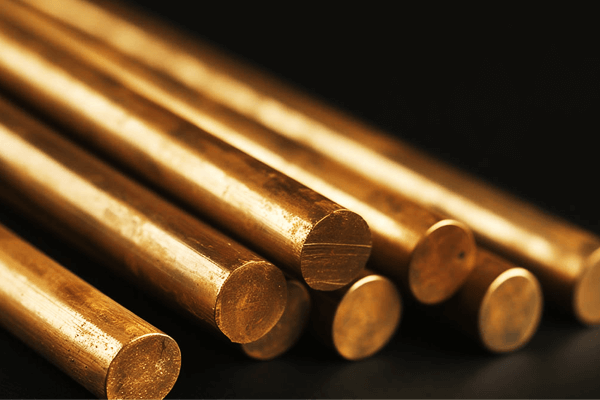
Pronssi on tunnettu siitä voimakkuus, ylivoimainen korroosionkestävyys, erinomainen kulumiskyky, ja kyky muodostaa vakaa suojaava patina, etenkin ankarissa ympäristöissä.
Sitä on käytetty tuhansia vuosia – aina pronssikaudelta – ja sitä käytetään edelleen laajalti meren-, rakenteellinen, sähkö-, taiteellinen, ja laakerisovellukset.
Avainero messingin ja pronssin välillä piilee niiden seosaineissa: messinki on ensisijaisesti kupari + sinkki, kun taas pronssi on yleensä kupari + tina (tai muita elementtejä, kuten Al, Ja, P, Mn).
Pronssilla on tyypillisesti suurempi lujuus, kovuus, ja korroosionkestävyys ja metallin väsyminen, tosin korkeammalla hinnalla ja pienemmällä työstettävyydellä kuin messingillä.
Kemiallinen koostumus & Alloy Systems
Pronssiseokset luokitellaan niiden ensisijaisen seostusaineen mukaan kuparin lisäksi:
- Fosfori pronssi (Cu-Sn-P)
-
- Tina sisältö: ~0,5–11 %, fosforin jäännöksellä
- Ominaispiirteet: Korkea väsymiskestävyys, alhainen kitka, erinomaiset jousiominaisuudet
- Sovellukset: Laakerit, jouset, sähköliittimet, vaihde
- Alumiininen pronssi (Cu-Al)
-
- Alumiinipitoisuus: ~5–12 %
- Ominaispiirteet: Poikkeuksellinen korroosionkestävyys (varsinkin suolaisessa vedessä), voimakkuus
- Sovellukset: Laivavarusteet, venttiilit, pumput, ilmailu- ja avaruusholkit
- Silikonin pronssi (Cu-Si)
-
- Piipitoisuus: ~2–6 %
- Ominaispiirteet: Hyvä heitettävyys, korroosionkestävyys, ja kohtalainen voima
- Sovellukset: Arkkitehtoninen laitteisto, veistoksia, kiinnittimet
- Mangaani pronssi (Cu–Zn–Mn–Fe)
-
- Teknisesti messinkivariantti, mutta usein ryhmitelty pronssien kanssa samanlaisten lujuusominaisuuksien vuoksi
- Ominaispiirteet: Korkea vetolujuus, Hyvä kulumisvastus
- Sovellukset: Raskaat laakerit, potkurin akselit, venttiilin varret
Yhteiset arvosanat ja standardit
| Luokka | Standardi | Tyypillinen koostumus | Ominaisuudet ja sovellukset |
| C51000 | ASTM B139 | Cu 95%, Sn 5%, P jälki | Fosforipronssi; korkea väsymiskestävyys ja jousiominaisuudet; käytetään holkeissa, vaihde, sähköiset koskettimet |
| C54400 | ASTM B139 | Cu 95%, Sn 4%, Pb 1% | Lyijyä sisältävä fosforipronssi; tarkkuuskomponenttien parannettu työstettävyys |
| C63000 | ASTM B150 | Cu 83%, AL -AL 10%, Sisä- 5%, Fe 2% | Nikkeli-alumiinipronssi; ylivoimainen korroosionkestävyys ja lujuus; ihanteellinen laivojen potkureihin, pumput |
| C64200 | ASTM B150 | Cu 93.5%, AL -AL 6%, Ja 0.5% | Silionialumiinipronssi; hyvä lujuus ja korroosionkestävyys; käytetään venttiilivarsissa ja kiinnikkeissä |
| C86300 | ASTM B271 | Cu 70%, Mn 2.5%, Fe 3%, Zn 24% | Mangaani pronssi; erittäin luja laakeriseos; käytetään kantaviin mekaanisiin osiin |
4. Messingin ja pronssin mekaaninen suorituskyky
Kun valitset pronssin tai messingin välillä teknisissä sovelluksissa, mekaaninen suorituskyky on kriittinen kriteeri.
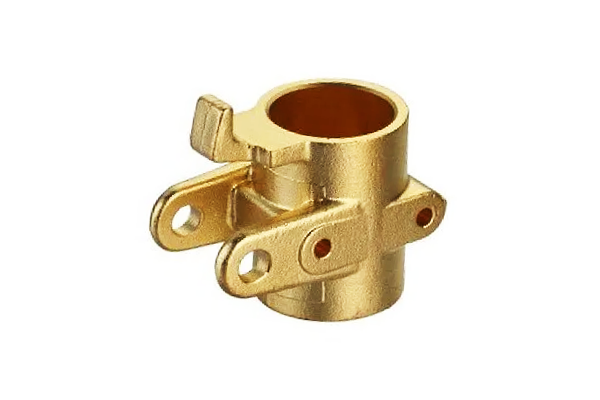
Vaikka molemmat ovat kuparipohjaisia seoksia, niiden mekaaniset ominaisuudet vaihtelevat merkittävästi koostumuksen mukaan, käsittely, ja vaiherakenne.
Mekaanisen lujuuden ja taipuisuuden vertailu
| Kevytmetallityyppi | Vetolujuus (MPA) | Tuottolujuus (MPA) | Pidennys (%) | Sitkeys (Laadullinen) |
| C26000 (Patruunan messinki) | 300–500 | 100–250 | 30–50 | Kohtuullinen |
| C36000 (Vapaasti leikkaava messinki) | 400–550 | 250–400 | 20–35 | Kohtalainen tai matala (johdon sisällön vuoksi) |
| C51000 (Fosfori pronssi) | 350–550 | 200–400 | 15–30 | Korkea (erinomainen syklisessä kuormituksessa) |
| C54400 (Lyijypitoinen fosforipronssi) | 400–600 | 250–450 | 12–25 | Korkea |
| C63000 (Alumiininen pronssi) | 550–800 | 300–600 | 10–20 | Erittäin korkea (iskuja ja väsymistä kestävä) |
| C86300 (Mangaani pronssi) | 600-850 | 400–600 | 10–20 | Korkea |
Kovuus (Brinell, Vickers, Rockwell)
| Kevytmetallityyppi | Brinell (HB) | Vickers (HV) | Rockwell (B/H) |
| C26000 messinki | ~65-110 | ~80-120 | ~RB 60-80 |
| C36000 Vapaaleikkaus | ~110-150 | ~120-160 | ~RB 80-95 |
| C51000 Phos Bronze | ~80-130 | ~100-160 | ~RB 70-85 |
| C63000 Al Bronze | ~150-200 | ~180-230 | ~RC 25–35 |
| C86300 Mn pronssia | ~170-230 | ~200-270 | ~RC 25–35 |
Väsymys syklisessä kuormituksessa
| Kevytmetallityyppi | Kestävyysraja (MPA) | Muistiinpanot |
| Alfa messinki (C26000) | ~ 100–150 | Herkkä pintavaurioille ja jännitysnousuille |
| Al pronssi (C63000) | ~250-350 | Ylivoimainen väsymiskestävyys |
| Fosfori pronssi | ~150-250 | Erinomainen syklisiin jousisovelluksiin |
5. Messinki vs. pronssi: Fyysinen & Lämpöominaisuuksien vertailutaulukko
| Omaisuus | Messinki (Tyypillinen alue) | Pronssi (Tyypillinen alue) | Huomautukset |
| Tiheys | 8.3 - 8.7 g/cm³ | 7.5 - 8.9 g/cm³ | Pronssi vaihtelee enemmän seosaineiden mukaan (esim. tina, alumiini, mangaani) |
| Erityinen vahvuus | 45 - 65 kN·m/kg | 55 - 85 kN·m/kg | Pronssi on yleensä vahvempaa painoyksikköä kohden |
| Lämmönjohtavuus | 95 - 130 W/m · k | 35 - 70 W/m · k | Messinki johtaa lämpöä paremmin; ihanteellinen lämmönsiirtoosille |
| Terminen diffuusio | ~3,5 – 4.0 mm²/s | ~1,8 – 2.8 mm²/s | Messinki levittää lämpöä nopeammin; pronssi vaimentaa lämmönvaihteluita |
| Lämpölaajennuskerroin (CTE) | ~20 - 21 × 10⁻⁶ /K | ~16 - 18 × 10⁻⁶ /K | Pronssi tarjoaa paremman mittavakauden lämpötilan vaihteluissa |
| Erityinen lämpökapasiteetti | ~0,38 J/g·K | ~0,35 J/g·K | Messinki hieman parempi lämmön varastointiin |
| Lämpöshokin kestävyys | Kohtuullinen | Korkea | Pronssi kestää halkeilua nopeassa lämpötilan muutoksessa |
| Ulottuvuusvakaus | Kohtalainen tai matala | Korkea | Pronssia suositaan tarkkuuslämpöpyöräilyympäristöissä |
6. Akustinen & Messingin ja pronssin esteettiset ominaisuudet
Resonanssi ja vaimennus soittimissa (kelloja, symbaalit, jouset)
- Vaskipuhaltimet: Messinki on ensisijainen materiaali soittimille, kuten trumpeteille, pasunat, ja sarvet.
Sen suhteellisen korkea akustinen impedanssi ja hyvät resonanssiominaisuudet mahdollistavat sen tuottavan kirkasta, voimakkaita ääniä.
Seoksen kyky värähtää vapaasti tietyillä taajuuksilla antaa vaskipuhaltimille niiden tyypilliset täyteläiset sävyt. - Pronssia lyömäsoittimissa: Pronssia käytetään laajalti lyömäsoittimissa, kuten kelloissa, symbaalit, ja gongit.
Tina-pronssit, erityisesti, tunnetaan erinomaisista akustisista ominaisuuksistaan.
Niissä on ainutlaatuinen yhdistelmä resonanssia ja vaimennusta, mikä johtaa lämpimään, täyteläinen ääni pitkällä kestolla.
Esimerkiksi, pronssista tehdyt kirkonkellot tuottavat syviä, sointuvat äänet, jotka voivat kantaa pitkiä matkoja.
Värispektri: keltainen messinki vs punertava pronssi vs kullattu viimeistely
- Väri Messinki: Messingin väri vaihtelee sen sinkkipitoisuuden mukaan. Vähäsinkin messingissä on punertavan keltainen sävy, kun taas enemmän sinkkiä sisältävät messingit ovat kullankeltaisempia.
Tämä kirkas, houkutteleva väri tekee messingistä suositun valinnan koristeellisissa sovelluksissa, kuten laitteisto, korut, ja arkkitehtonisia aksentteja. - Väri pronssi: Pronssilla on tyypillisesti punertavanruskea väri, joka voi vaihdella hieman seoksen koostumuksesta riippuen.
Ajan myötä, pronssiin voi muodostua patina, joka voi vaihdella vihertävän sinisestä (ulkotiloissa) tummempiin ruskeisiin, lisää sen esteettistä vetovoimaa, erityisesti taiteessa ja arkkitehtonisissa veistoksissa. - Kullattu viimeistely: Sekä messinki että pronssi voidaan viimeistellä kullalla niiden ulkonäön parantamiseksi.
Kullatut pinnat voivat vaihdella kirkkaasta kullanomaisista pinnoitteista antiikkimaisempiin patinoihin, mahdollistaa laajan valikoiman esteettisiä vaihtoehtoja koristetuotteissa.
Sisustustekniikat: etsaus, patinointi, pinnoitus
- Etsaus: Sekä messinkiä että pronssia voidaan kaivertaa monimutkaisten kuvioiden luomiseksi. Etsaus tarkoittaa kemikaalien käyttöä materiaalin valikoivaan poistamiseen pinnalta, paljastaa halutun kuvion.
Tätä tekniikkaa käytetään yleisesti koristelaattojen valmistuksessa, kolikoita, ja taideesineitä. - Patinointi: Kuten aiemmin mainittiin, pronssille kehittyy luonnollisesti patina ajan myötä. Kuitenkin, Patinointi voidaan myös aiheuttaa keinotekoisesti tiettyjen esteettisten vaikutusten saavuttamiseksi.
Messingissä, Patinointitekniikoilla voidaan luoda vanhentuneita tai antiikkisen näköisiä viimeistelyjä. - Pinnoitus: Pinnoitus on toinen suosittu sisustustekniikka. Messinki voidaan pinnoittaa kullalla, hopea, tai nikkeliä parantamaan sen ulkonäköä ja suojaamaan sitä korroosiolta.
Pronssia voidaan myös pinnoittaa, vaikka se on vähemmän yleinen johtuen sen luonnollisesta esteettisestä viehättävyydestä ja pinnoitteen mahdollisuudesta häiritä sen ominaisen patinan kehittymistä.
7. Sähköinen & Pronssin vs messingin magneettiset ominaisuudet
Messingillä ja pronssilla on erilainen sähköinen ja magneettinen käyttäytyminen, jotka vaikuttavat niiden soveltuvuuteen sähkökäyttöön, elektroninen, ja sähkömagneettiset häiriöt (EMI) sovellukset.
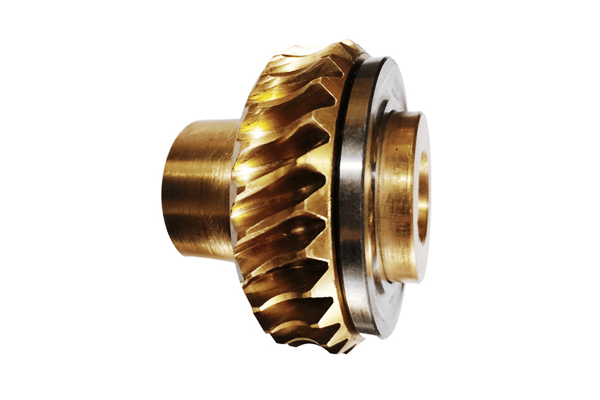
Sähkönjohtavuus
| Materiaali | Sähkönjohtavuus (% IACS)* | Tyypilliset sovellukset |
| Messinki (C26000) | 15 - 28% | Sähköliittimet, terminaalit, kytkimet |
| Fosfori pronssi (C51000) | 5 - 8% | Jouset, liittimet, heikkovirtakoskettimet |
| Alumiininen pronssi (C63000) | 7 - 10% | Korroosionkestävät liittimet, erikoistuneet kontaktit |
IACS = kansainvälinen hehkutetun kuparin standardi (100% = puhtaan kuparin johtavuus)
- Messinkilejeeringit yleensä tarjota kohtalainen sähkönjohtavuus, riittää monille sähkökomponenteille, joissa johtavuus ja mekaaninen lujuus ovat tasapainossa.
- Pronssilejeeringit on alhaisempi sähkönjohtavuus, suurelta osin niiden seosaineiden vuoksi (tina, fosfori, alumiini),
tekee niistä vähemmän sopivia kohteisiin, joissa vaaditaan korkeaa sähkönjohtavuutta, mutta arvokkaita siellä, missä mekaaninen lujuus ja korroosionkestävyys ovat etusijalla.
Magneettiset ominaisuudet
| Materiaali | Magneettinen läpäisevyys (µr) | Magneettinen käyttäytyminen |
| Messinki | ~1.0 (ei-magneettinen) | Pohjimmiltaan ei-magneettinen |
| Fosfori pronssi | ~1.0 (ei-magneettinen) | Ei-magneettinen |
| Mangaani pronssi | Hieman magneettinen | Voi osoittaa heikkoa magnetismia |
- Molemmat messinki ja useimmat pronssiseokset ovat ei-magneettisia, mikä on edullista sovelluksissa, jotka vaativat minimaalista magneettista häiriötä.
- Jotkut erikoistuneet pronssit, kuten mangaanipronssi Niillä voi olla vähäisiä magneettisia ominaisuuksia, mutta ne ovat suurelta osin ei-ferromagneettisia.
EMI/RFI-suojauksen huomioitavaa
- Kohtuullisen johtavuuden ja ei-magneettisen luonteen vuoksi, messinki käytetään usein EMI/RFI-suojauskomponentit kuten liittimet ja kotelot, johtavuuden tasapainottaminen mekaanisen kestävyyden kanssa.
- Pronssin alempi johtavuus heikentää sen suojauksen tehokkuutta messingiin verrattuna,
mutta sen ylivoimainen korroosionkestävyys tekee siitä sopivan vaativiin ympäristöihin, joissa EMI-suojaus on toissijainen. - Pinnoitus erittäin johtavilla metalleilla (ESIM., hopeaa tai kuparia) joko messingillä tai pronssilla voi parantaa pinnan johtavuutta ja parantaa EMI/RFI-suorituskykyä.
8. Korroosionkestävyys & Pinnan käyttäytyminen
- Sinkinpoisto: Messinki voi kärsiä sinkin huuhtoutumisesta syövyttävissä tai runsaasti kloridia sisältävissä ympäristöissä, heikentää materiaalia.
- Tinan liuotus: Pronssi kestää yleistä korroosiota paremmin eikä sinkki hajoa, vaikka tina voi huuhtoutua hyvin happamissa väliaineissa.
- Stressikorroosion halkeaminen: Messinki on herkempi, erityisesti ammoniakkipitoisissa ympäristöissä.
- Marine Performance: Alumiini ja piipronssit ovat poikkeuksellisen korroosionkestävä, käytetty laajasti vuonna meri- ja offshore-rakenteet.
- Patina: Pronssimuodot a vakaa, suojaava patina, kun taas messinki tummuu ja saattaa vaatia kiillotusta tai tiivistämistä.
9. Valmistus & Messingin ja pronssin muodostuminen
Casting Behavior: Juoksevuus, Kutistuminen, ja huokoisuus
Valu on edelleen monien messinki- ja pronssikomponenttien ensisijainen valmistusreitti. Niiden valuominaisuuksien ymmärtäminen auttaa optimoimaan suunnittelun ja minimoimaan viat.

- Messingillä on erinomainen juoksevuus, arvot saavuttavat noin 40–45 cm juoksevuustestiasteikolla, mahdollistaa monimutkaiset geometriat, kuten yksityiskohtaiset arkkitehtoniset varusteet ja tarkkuusventtiilit.
Sen kutistumisnopeus jää tyypillisesti väliin 1.5% ja 2.0%, mikä auttaa säilyttämään mittatarkkuuden. - Sitä vastoin, pronssiseokset osoittavat kohtalaista juoksevuutta, vaihtelevat noin 30-38 cm, joka haastaa erittäin ohutseinäisten tai monimutkaisten muotojen valun.
Kutistuminen voi nousta 2.0% -lla 2.5%, muottien suunnittelussa on huomioitava valuvirheiden välttäminen.
Huokoisuus on yleisempää pronssivaluissa, varsinkin ilman optimoituja jäähdytysjärjestelmiä, vaikuttaa mekaaniseen eheyteen.
Kylmästö: Muovattavuus ja muovausrajat
Kylmätyöstö muotoilee metalleja niiden uudelleenkiteytyslämpötilan alapuolella, lujuuden lisääminen jännityskarkaisulla, mutta vaatii riittävää taipuisuutta.
- Messinki loistaa kylmätyöstettävyydessä sinkkipitoisuutensa ja mikrorakenteensa ansiosta, saavuttaa usein venymäarvot välillä 30–50% vetokokeissa hehkutuksen jälkeen.
Tämä mahdollistaa laajat toiminnot, kuten syväveto, taivutus pienillä säteillä (jopa 3–5 mm levyinä), ja hieno langanveto. - Pronssin sitkeys vaihtelee seostettujen alkuaineiden mukaan; esimerkiksi, fosforipronssin venymä on 15–35 %, kun taas alumiinipronssi laskee 10–20 %.
Näiden metalliseosten kylmämuovaus vaatii suurempia taivutussäteitä (tyypillisesti >10 mm) ja välihehkutus halkeilun välttämiseksi.
Kuuma työ & Hehkutus: Lämpötila ja vaste
Kuumatyöstö jalostaa mikrorakennetta ja sallii muodonmuutoksen kylmämuovauksen rajojen yli.
- Messinki hehkuu tehokkaasti välillä 450°C ja 600 °C, uudelleenkiteytys valmistui minuuteissa.
Kuumavalssaus tai taonta tuottaa tasaisen raekoon, sitkeyden ja taipuisuuden parantaminen. - Pronssi vaatii korkeampia lämpötiloja - usein 600°C - 900 °C - ja pidemmät hehkutusajat, joskus useita tunteja, elastisuuden palauttamiseksi.
Alumiininen pronssi, esimerkiksi, vaatii huolellista valvontaa, jotta vältetään jyvien karkeneminen, joka voi heikentää mekaanisia ominaisuuksia.
Työstettävyys ja työkalut: Tehokkuus ja haasteet
Työstettävyys vaikuttaa sykliaikoihin, työkalukustannukset, ja pinnan viimeistelyn laatu.
- Messingin työstettävyysluokitus vaihtelee 70% -lla 100% vapaasti työstettävän messingin standardeihin verrattuna.
Se tuottaa jatkuvaa, helposti hallittavat lastut ja vaatii kohtuullisia leikkausvoimia.
Kovametallityökalut käsittelevät tehokkaasti messinkiä, mahdollistaa nopean koneistuksen minimaalisella työkalun kulumisella. - Pronssiseosten työstettävyys on vaihtelevampaa ja yleensä alhaisempi, arvosanat välillä 40% ja 70%.
Alumiinipronssit ja mangaanipronssit ovat erityisen hankaavia, lisää työkalujen kulumista.
Pronssin työstäminen vaatii usein kobolttipohjaisia tai keraamisia työkaluja ja pienennettyjä leikkausnopeuksia työkalun käyttöiän ylläpitämiseksi.
10. Liittyy & Messinki vs pronssi kokoonpano
Messinki- ja pronssikomponenttien yhdistäminen on kriittinen osa niiden käyttöä putkistoissa, sähköjärjestelmät, rakennekokoonpanot, ja taiteellisia teoksia.
Messingin juottaminen vs pronssin juottaminen
Messingin juottaminen:
Messinki soveltuu erinomaisesti sekä pehmeään että kovaan juottamiseen hyvän lämmönjohtavuuden ja yleisten täyteaineiden kanssa yhteensopivuuden ansiosta.
- Pehmeä juotos (< 450° C) sopii erinomaisesti kevyisiin sovelluksiin, kuten koruihin, pienet elektroniset päätteet, ja koriste-osat.
- Lyijypohjaiset juotokset (ESIM., Sn-Pb 60/40) tarjoavat hyvän kostutuskyvyn ja kohtuullisen lujuuden; kuitenkin,
lyijyttömät juotokset (ESIM., Sn-Ag tai Sn-Cu) ovat nyt laajalti käytössä RoHS-yhteensopivissa tuotteissa. - Kova juottaminen (hopean juottaminen) käyttää korkealla sulavia juotteita (450-800°C),
kuten Ag-Cu-Zn-seokset, luoda vahvoja liitoksia vaskipuhaltimiin, raskaita putkistoja, ja mekaaniset liitokset.
Pronssinen juotos:
Juottaminen on suositeltavin pronssin liitosmenetelmä sen korkeamman sulamispisteen ja lujuusvaatimusten vuoksi.
- Tyypilliset juotoslämpötilat vaihtelevat 750°C - 950 °C, riippuen seoksen koostumuksesta.
- Tina-pronssi ja fosforipronssi juotetaan usein Cu-P- tai Cu-Sn-täytemetalleilla, valittu vastaamaan läheisesti perusmetallin ominaisuuksia ja vähentämään galvaanisia vaikutuksia.
- Alumiini- ja mangaanipronssit vaativat erikoistäyteaineita, joiden alumiinipitoisuus on yhteensopiva, jotta vältetään faasiepäsopivuus ja metallien välinen muodostuminen.
- Suutteet tai inertit atmosfäärit ovat usein tarpeen hapettumisen estämiseksi korkean lämpötilan liittämisen aikana.
Mekaaninen liitos (Kierteet, Paina Sopivat)
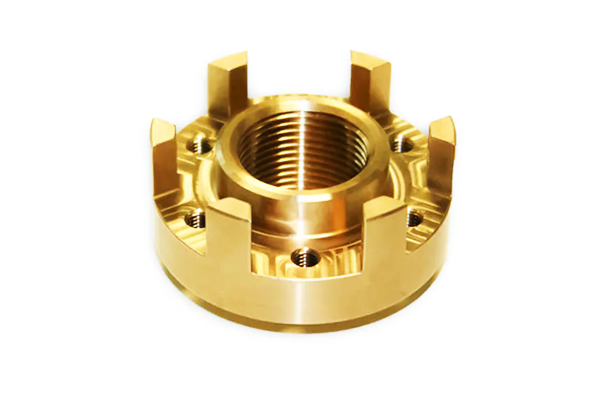
Messingin mekaaninen liitos:
- Messingin erinomainen työstettävyys tekee siitä ihanteellisen kierreliitokset, erityisesti nesteenkäsittelyjärjestelmissä, kuten putkiliitokset, venttiilit, ja anturikotelot.
- Puristus sopii Niitä käytetään yleisesti matalan tai kohtalaisen kuormituksen sovelluksissa.
Messingin taipuisuus mahdollistaa lievän elastisen muodonmuutoksen työntämisen aikana, varmistaa tiukan ja tärinää kestävän liitoksen.
Pronssinen mekaaninen liitos:
- Johtuen suurempi kovuus ja lujuus, pronssikomponentit, joita käytetään raskaissa sovelluksissa (ESIM., kotelot, meriventtiilit) luottavat usein vankoihin kierremuotoihin ja tiukempiin puristussovitustoleransseihin.
- Kovemmat pronssilejeeringit kuten mangaanipronssi tai berylliumpronssi vaativat tarkan koneistuksen ja joskus esilämmitys koteloita helpottaakseen häiriösovituksia aiheuttamatta halkeamia.
Vertailu:
- Langan katkaisunopeus: Messinki – korkea (300-400 SFM); Pronssi - kohtalainen (150–250 SFM)
- Paina Sovita toleranssialue (⌀25 mm akselille): Messinki ~25-50 µm; Pronssi ~15-35 µm
Liimaus yhteensopivuus
Messingin liimaus:
- Messinki tarttuu hyvin epoksit, syanoakrylaatit, ja anaerobiset liimat, erityisesti vähärasitusasennelmissa.
- Parhaan tuloksen saavuttamiseksi:
-
- Puhdista isopropyylialkoholilla tai asetonilla
- Hiero pintaa kevyesti kontaktialueen lisäämiseksi
- Levitä liimaa ja purista 5–30 minuuttia koostumuksesta riippuen
Sovellukset sisältävät koristeelliset kiinnikkeet, kellotaulumittareita, ja koristerakenteet.
Pronssinen liimaus:
- Pronssi vaatii enemmän tiukka pinnan valmistelu nopean oksidin muodostumisen takia.
-
- Suositeltava: kemiallinen etsaus (ESIM., fosforihappo) tai hiekkapuhallus, jota seuraa välitön liimaus.
- Erittäin lujat epoksiliimat venymisen kanssa >5% ovat suositeltavia, erityisesti rakenteellisiin tai tärinäalttiisiin liitoksiin.
Sopii käytettäväksi työkalun lisäosat, rakennekorjaus, ja taideinstallaatioita, varsinkin jos hitsaus ei ole mahdollista.
11. Messingin ja pronssin tärkeimmät teolliset sovellukset
Messinki ja pronssi ovat ansainneet paikkansa nykyaikaisessa teollisuudessa vuosisatojen luotettavan suorituskyvyn ansiosta.
Niiden erilaiset mekaanisen lujuuden yhdistelmät, korroosionkestävyys, ja toimivuus tekevät niistä välttämättömiä monilla aloilla.
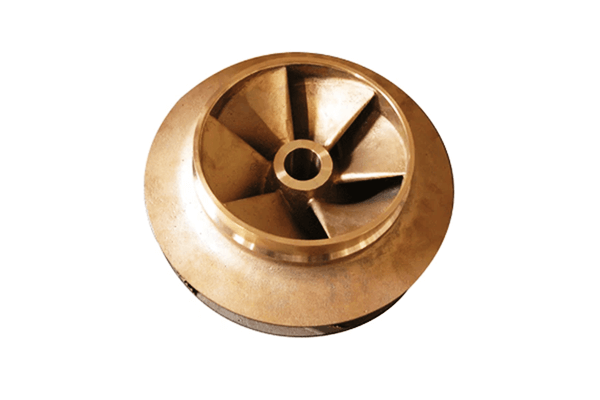
Messingin teolliset sovellukset
Putki- ja nesteidenkäsittelyjärjestelmät
Messingin erinomainen työstettävyys, korroosionkestävyys juomavedessä, ja tiivistyskyky tekevät siitä suosituimman metallin komponenteille, kuten:
- Putkivarusteet
- Venttiilit
- Hanat
- Puristushihat
- Sprinklerisuuttimet
Sähkö- ja elektroniikkateollisuus
Messingin hyvä sähkönjohtavuus ja ei-magneettiset ominaisuudet ovat ihanteellisia sähkölaitteille, kuten:
- Liitinrimat ja pistorasiat
- Liittimet ja kytkimien koskettimet
- Kaapelikengät ja maadoituskiinnittimet
- Painettu piirilevy (PCB) vastakohdat
Tarkkuusinstrumentit ja kellot
Sen mittavakaus ja alhaiset kitkaominaisuudet tukevat sen käyttöä:
- Vaihteet ja kellon pyörät
- Kalibrointinupit
- Kellot ja kehykset
Koristearkkitehtuuri ja laitteistot
Messingin kultainen estetiikka ja tummumisenkestävyys mahdollistavat pitkäaikaisen käytön:
- Oven kahvat ja lukot
- Kaiteet ja arkkitehtiverhoilu
- Soittimet (trumpetti, sarvet)
- Valaisimet ja koristeritilät
Auto- ja ilmailukomponentit
Messinkiä käytetään, kun sähköinen suorituskyky ja korroosionkestävyys ovat kriittisiä:
- Jäähdyttimen sydämet ja lämmityselementit
- Jarruletkujen kiinnikkeet
- Polttoainetunnistimen kotelot
Ampuma- ja puolustusteollisuus
Mukavuuden ja korroosionkestävyyden ansiosta, messinkiä käytetään laajasti:
- Kasettikotelot
- Kuorikotelot
- Sulakekomponentit
Pronssin teolliset sovellukset
Laakerit ja holkit
Pronssiseokset – erityisesti tina-pronssi ja lyijyllinen pronssi – tarjoavat erinomaisen kulutuskestävyyden ja upottavuuden, välttämätön:
- Liukuholkkilaakerit
- Työntölevyt
- Ohjausholkit hydraulijärjestelmissä
Meren ja offshore-tekniikka
Pronssin ylivoimainen suolaveden korroosionkestävyys tekee siitä välttämättömän:
- Potkurit ja juoksupyörät
- Venttiilien istukat ja pumppupesät
- Merivesiputkiston komponentit
- Upotettavat moottorin kotelot
Raskaat laitteet ja teollisuuskoneet
Korkealle kuormitukselle, hitaita sovelluksia, pronssikomponentit auttavat vähentämään kitkaa ja kulumista:
- Hammaspyörät ja kierukkavaihteet
- Liukuvat kulutuslevyt
- Laakerikotelot ja tiivisteet
Ilmailu- ja puolustusjärjestelmät
Erikoispronssia, kuten alumiinipronssia ja berylliumpronssia, käytetään kriittisissä sovelluksissa, joissa lujuus ja väsymiskestävyys ovat tärkeitä:
- Rakenteelliset kiinnikkeet
- Korkean jännityksen laskutelineiden holkit
- Jousiominaisuuksilla varustetut sähköliittimet
Veistos ja kuvataide
Valuominaisuuksiensa ja patinan muodostumisen ansiosta, pronssi on perinteinen ja nykyaikainen materiaali:
- Monumentaaliset veistokset
- Mitalit ja muistolaatat
- Taiteelliset valut ja restauroinnit
Lisäainevalmistus ja edistynyt valmistus
Metallin 3D-tulostuksen kasvun myötä, tiettyjä pronssiseoksia tutkitaan:
- Räätälöidyt taideteokset
- Kulutusta kestävät työkalut
- Esteettisesti arvostettujen mekaanisten komponenttien prototyypit
12. Pronssi vs messinki plussat ja miinukset
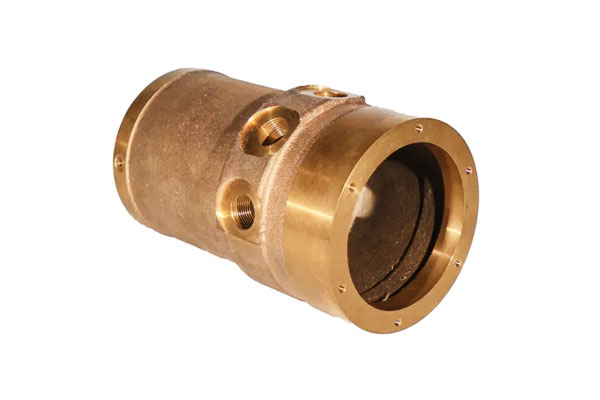
Messinki-ammattilaiset:
- Erinomainen konettavuus
- Korkea johtavuus
- Edullinen
- Hyvä esteettinen lajike
Messinki miinukset:
- Sinkin hajoamisen riski
- Alempi vahvuus
- Altis tummua
Pronssiammattilaiset:
- Korkea lujuus ja kulutuskestävyys
- Ylivoimainen korroosionkestävyys
- Sopii erinomaisesti laakereille ja veneen osiin
- Kaunis patina ajan myötä
Pronssi miinukset:
- Vaikeampi koneistaa
- Kalliimpi
- Alempi lämmön- ja sähkönjohtavuus
13. Vertailutaulukko: Messinki vs. pronssi
| Luokka | Messinki | Pronssi |
| Pohjan koostumus | Kupari + Sinkki | Kupari + Tina (tai muita elementtejä) |
| Yleiset seosaineet | Sinkki, Johtaa (vapaa koneistus), Nikkeli (nikkeli hopeaa) | Tina, Alumiini, Pii, Fosfori, Mangaani, Beryllium |
| Väri | Kirkkaasta kullasta keltaiseen (korkeampi Zn) | Punaruskea, joskus kultainen; patinaa ajan myötä |
| Tiheys (g/cm³) | ~8,4-8,7 | ~8,7-8,9 |
| Vetolujuus (MPA) | 300–550 | 350–800 (Alumiinipronssi aina 900 MPA) |
| Tuottolujuus (MPA) | 100–350 | 200–600 |
| Pidennys (%) | 20–50 | 10–35 |
| Kovuus (Brinell HB) | 50–150 (vaihtelee seoksen mukaan) | 60–210 (Alumiinipronssi voi ylittää 200 HB) |
| Lämmönjohtavuus (W/m · k) | ~100-130 | ~50-70 (Tina pronssi); niin alhainen kuin 35 joillekin alumiinipronssille |
| Sähkönjohtavuus (%IACS) | 28–40% | 7–15% (paljon alhaisempi johtuen tinasta tai alumiinista) |
| Korroosionkestävyys | Hyvä; alttiita sinkinpoistolle ammoniakissa/suolaliuoksessa | Erinomainen, etenkin meriympäristöissä; immuuni sinkinpoistolle |
| Toimitettavuus (Konettavuus) | Erinomainen, varsinkin lyijyllisen messingin kanssa | Kohtalainen hyvä; vaihtelee suuresti seostyypin mukaan |
| Kestävyys | Erittäin hyvä | Erinomainen, erityisesti taiteellisiin valuihin |
| Kylmätyöstettävyys | Erinomainen; voidaan piirtää, leimattu, kehrätty | Kohtuullinen; rajoitetumpi kovempiin pronssiin |
| Maksaa | Yleensä alhaisempi | Yleensä korkeampi, erityisesti alumiini ja erikoispronssit |
Äänenlaatu (Musiikillinen käyttö) |
Kirkas, teräviä sävyjä (trumpetti, sarvet) | Lämmin, kaikuvat sävyt (kelloja, symbaalit, gongit) |
| Patinan muodostuminen | Tummenee ajan myötä tummanruskeaksi tai vihreäksi | Muodostaa esteettisesti miellyttävän vihreän/sinisen patinan pitkäksi aikaa |
| Magneettinen läpäisevyys | Ei-magneettinen | Ei-magneettinen (Jotkut alumiinipronssit voivat olla heikosti magneettisia) |
| Juotos/juotto | Helposti juotettu; sinkki voi haihtua hitsauksen aikana | Tyypillisesti juotettu; erityisiä täyteaineseoksia, joita tarvitaan korkeaan suorituskykyyn |
| Soveltuvuus merelle | Rajoitettu – vain tietyt seokset (ESIM., laivaston messinki) | Erinomainen – ihanteellinen merivedelle alttiisiin osiin |
| Tärkeimmät teollisuussovellukset | LVI-varusteet, soittimet, sähköliittimet | Laakerit, holkit, laivan potkurit, veistos, korkea kuormitussovellukset |
| Kierrätys | Erittäin kierrätettävä | Erittäin kierrätettävä |
14. Johtopäätös
Messinkiä ja pronssia, kun taas kemiallisesti samanlaisia ovat kuparipohjaisia seoksia, tarjoavat täysin erilaisia ominaisuuksia ja sovelluksia.
Messinki on erinomainen sisä- johtavuus, Muokkaus, ja kustannukset, joten se sopii erinomaisesti sähkö- ja putkitöihin. Pronssi erottuu sisä- vahvuus, korroosionkestävyys, ja pitkäikäisyys
Valinta messingin ja pronssin välillä vaatii yksityiskohtaista ymmärrystä suorituskykyvaatimukset, ympäristöolosuhteet, ja kustannusrajoituksia.
Kohdistamalla materiaalin ominaisuudet sovelluksen vaatimuksiin, insinöörit ja suunnittelijat voivat varmistaa pitkän käyttöiän, luotettavuus, ja esteettinen arvo tuotteissaan.
Faqit
Mikä on parempi: Pronssi tai messinki?
Se riippuu sovelluksesta.
- Messinki sopii paremmin sovelluksiin, jotka vaativat hyvä konettavuus, sähkönjohtavuus, ja a kirkas, koristeellinen ulkonäkö, kuten putkisto, soittimet, ja sähköliittimet.
- Pronssi sopii paremmin korkea lujuus, kulutusta kestävä, ja korroosiokestävä sovellukset, etenkin meren-, laakeri, ja raskaita koneita ympäristö.
Lyhyesti sanottuna:
- Valita messinki esteettisyyden ja muotoilun helppouden vuoksi.
- Valita pronssi voimaa varten, kestävyys, ja ankarissa ympäristöissä.
Onko messinki vai pronssi kalliimpaa?
Pronssi on yleensä kalliimpaa kuin messinki.
- Tämä johtuu sen korkeammasta pitoisuudesta tina, alumiini, tai muita erikoisosia pitää beryllium, jotka ovat kalliimpia kuin sinkki (käytetään messingissä).
- Lisäksi, pronssiseokset Niillä on yleensä monimutkaisempi käsittely, ja niitä käytetään usein kriittiset tai korkean suorituskyvyn sovellukset, lisää kustannuksia entisestään.
Mistä tiedät, onko se pronssia vai messinkiä?
Tässä ovat tärkeimmät tavat erottaa toisistaan messingin ja pronssin välissä:
- Väri:
-
- Messinki: Keltaisesta kultaan, riippuen sinkkipitoisuudesta.
- Pronssi: Punaruskea, usein tummempi tai patinainen.
- Ääni (Tonaalinen laatu):
-
- Lyö esineeseen varovasti: Messinki kuulostaa usein korkeammalta ja "renkaalta", kun taas pronssi antaa syvemmän, resonoivampi sävy.
- Magnetismi:
-
- Molemmat ovat ei-magneettinen, mutta pronssilejeeringit voivat sisältää jäämiä raudasta tai muista alkuaineista, jotka osoittavat lievää magneettista käyttäytymistä.
- Spark Test (jos on turvallista suorittaa):
-
- Pronssi tuottaa lyhyempi, punaisempia kipinöitä, kun taas messinkikipinät ovat kirkkaampia ja kelta-valkoisempia.
Miksi pronssia ei enää käytetä laajalti??
Pronssia käytetään edelleen, mutta:
- Siitä on tullut harvinaisempaa kuluttajatuotteissa johtuen korkeammat materiaalikustannukset ja ja taloudellisempien vaihtoehtojen nousu kuin messinkiä, muovit, ja ruostumatonta terästä.
- Messinki, on helpompi koneistaa ja halvempaa tuottaa, on korvattu pronssilla monissa ei-kriittisissä sovelluksissa, joissa erittäin korkea lujuus tai korroosionkestävyys ei ole välttämätön.
- Sisä- moderni tekniikka, pronssi on varattu erityisiä rooleja (ESIM., laivan potkurit, holkit) jossa sen ainutlaatuiset ominaisuudet ovat välttämättömiä.



